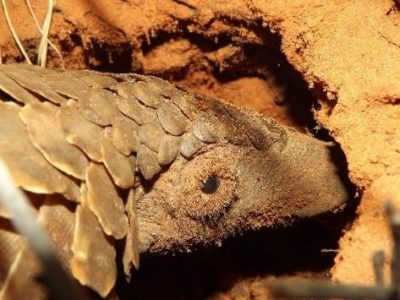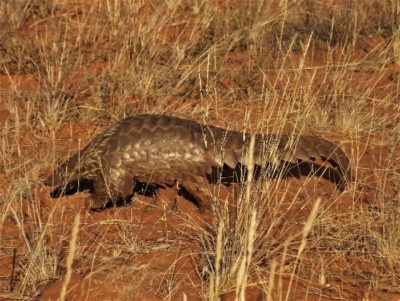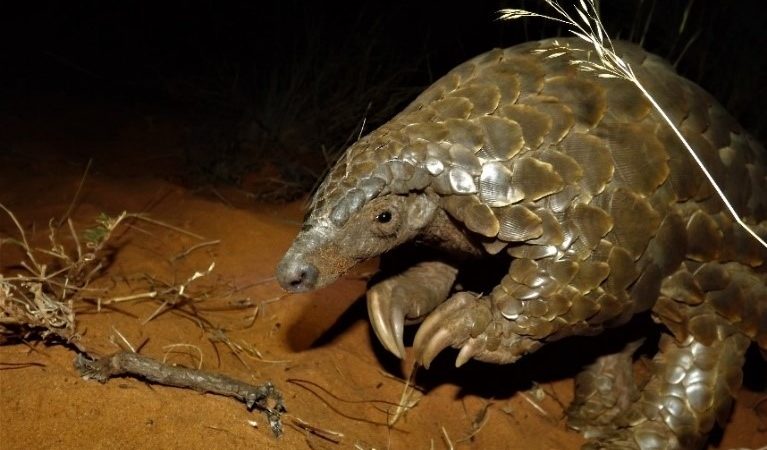Pangolins have gained fame over the past decade, unfortunately not for good reasons. Currently listed as the most illegally trafficked mammal in the world, pangolin numbers are declining at alarming rates. In 2017, all eight pangolin species were up-listed to Appendix I of CITES (Convention on International Trade in Endangered Species), which awards the maximum level of protection to a species that is threatened with extinction. The four Asian pangolin species (Chinese pangolin, Manis pentadactyla; Sunda pangolin, M. javanica; Indian pangolin, M. crassicaudata; and Philippine pangolin, M. culionensis) are listed as endangered on the IUCN (International Union for Conservation of Nature) list of threatened species. The four African pangolin species (ground pangolin, Smutsia temminckii; giant pangolin, Manis gigantea; black-bellied pangolin, Phataginus tetradactyla; and white-bellied pangolin, Phataginus tricuspis) are listed as vulnerable by the IUCN, however, as a result of the rapid decline of the Asian species, the demand for the African species by illegal wildlife trade is increasing.
In addition to wildlife trade, threats to pangolins include road mortalities, habitat loss, and electrocution by fences surrounding reserves. Improving our understanding of pangolin spatial use, habitat selection, and behaviour is essential for effective management and conservation practices. Understanding behaviour and dietary patterns of pangolins also will aid in the husbandry of a species that has not been successfully managed in captivity; captive populations may be required to ensure the species’ survival if the trade continues to increase at its current rapid rate.
Regional Scale Research
When it comes to wildlife conservation, a detailed understanding of specific populations is particularly vital if we are to develop effective conservation practices. It is easy enough to say that pangolin numbers are declining due to the numbers we see being traded and confiscated globally, however the extent of the damage to wild population numbers is relatively difficult to quantify if we do not have an idea of population densities that exist at a regional scale. Whilst a systems approach to conservation is equally important, we cannot assess the effects of the presence or absence of a certain species on a system if there is no understanding of how the individuals of that species function in their ecosystem. A bottom-up approach is thus required if we hope to improve conservation efforts of wildlife globally.

Studying individuals or populations from various localities will allow us to understand the diversity of factors which influence the survival of these populations at a regional scale, through which we can place the pieces of the puzzle together to understand the bigger picture. Such an approach will prevent us from drawing inaccurate conclusions about the species as a whole. For example, the insect diet of ground pangolins in the eastern, more mesic areas of southern Africa may differ from that of ground pangolins in the western, more arid regions. Once we understand how the variables that influence pangolin biology differ regionally, we may begin to understand more about how the complex variables act on one another to form a functional ecosystem.
Globally, very little attention has been given to the ground pangolin, which is the most widespread pangolin species in Africa, where it inhabits areas of eastern and southern Africa. Though there has been a recent increase in peer-reviewed research on ground pangolins, a review of the literature from the past 60 years reveals only two ecological studies have been conducted on ground pangolins that inhabit the arid areas of Africa. If we wish to protect South Africa’s biodiversity, there is a need to conduct detailed, long-term ecological research on various populations that span a diversity of habitats. For example, climate change poses an additional potential threat to ground pangolins in arid areas. Climate change models predict that the arid areas of Africa will become hotter and drier, and if ground pangolins or their prey items are not able to adapt to these changes, then they likely will face the risk of extinction or extirpation. There is thus a need to close the knowledge gap of the ecology of ground pangolins found in the arid regions of Africa so that suitable comparisons between different regional populations can be made.

In fulfilment of a PhD degree, I am currently conducting research at Tswalu Kalahari Reserve, which is situated on the south-west edge of the ground pangolin distribution range. My research is the first long-term, detailed study of this species’ physiology and ecology. Through the use of VHF telemetry technology, I have been able to track and follow wild pangolins at Tswalu for nearly two years now. Along with being able to measure core body temperature of the pangolins, I have been able to document several interesting behaviours, dietary patterns and movements. This study will provide insights into the life of pangolins in a semi-arid environment at a regional scale, which will hopefully contribute pieces to the bigger puzzle of global pangolin conservation.
In conclusion, my research on a wild population of pangolins at a regional scale will provide valuable information that can be used to ensure the survival of a species that is already severely threatened by the illegal wildlife trade. There is still a need to investigate the densities of populations throughout the ground pangolin distribution range, coupled with other ecological aspects if we hope to understand the effects of the wildlife trade on wild population numbers and to assist in implementing effective fine-scale conservation strategies.
Wendy Panaino is a PhD candidate at Wits University.
The MAHB Blog is a venture of the Millennium Alliance for Humanity and the Biosphere. Questions should be directed to joan@mahbonline.org
MAHB Blog: https://mahb.stanford.edu/blog/pangolin-conservation/
The views and opinions expressed through the MAHB Website are those of the contributing authors and do not necessarily reflect an official position of the MAHB. The MAHB aims to share a range of perspectives and welcomes the discussions that they prompt.
